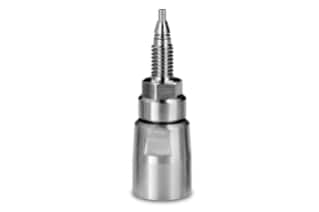
|
Chemistry |
C18 |
|
Separation Mode |
Reversed Phase |
|
Particle Substrate |
Hybrid |
|
pH Range Min |
1 pH |
|
pH Range Max |
12 pH |
|
Maximum Pressure |
6000 psi (415 Bar) |
|
Endcapped |
Yes |
|
Silanol Activity |
Low |
|
Particle Shape |
Spherical |
|
Particle Size |
3.5 µm |
|
Endfitting Type |
Waters |
|
Pore Size |
130 Å |
|
Format |
Column |
|
Surface Area |
185 |
|
System |
HPLC |
|
Particle Technology |
BEH |
|
USP Classification |
L1 |
|
Inner Diameter |
2.1 mm |
|
Length |
50 mm |
|
Carbon Load |
18 % |
|
UNSPSC |
41115709 |
|
Brand |
XBridge |
|
Product Type |
Columns |
|
Units per Package |
1 pk |


XBridge BEH C18 Column, 130Å, 3.5 µm, 2.1 mm X 50 mm, 1/pk
Depend on the XBridge BEH C18 Column for reliable performance each time. A reliable column performance is crucial for method reliability. To ensure this, column manufacturing is carefully monitored and every step tightly controlled to maintain product reproducibility. Tests are conducted every step of the way starting from raw material characterization to final batch analysis so that you get reliable results in every batch and column, no matter how many times you perform analysis.
Maximize your productivity with XBridge BEH C18 Column as they are designed to give unrivaled versatility. Whether you need to develop a cutting-edge LC/MS assay or create a quality control method the XBridge BEH C18 Column will enable you to do this while providing improved pH stability (1-12). With the XBridge BEH C18 Column, you can be certain of increased column lifetime and enhanced column reliability while leveraging assay ruggedness.
Develop unmatched peak shape and peak capacity using the XBridge BEH C18 Column by maximizing particle efficiency.
You may also be interested in other lab equipment such as the XBridge BEH C18 Column, 300Å, 2.5 µm, 4.6mm X 150 mm, 1/pk 300Å, 2.5 µm, 4.6mm X 150 mm, 1/pk, similar to the product listed here but suitable for analytes with particle size 2.5 µm and pore size 300Å.
Shop for lab equipment and see the complete available range of Waters XBridge BEH Columns, and browse through other suitable lab equipment as well.
What Is The Difference Between Gas And Liquid Chromatography?
The two types of chromatography techniques that are distinguished on the bases of the physical state of the mobile phase are gas and liquid chromatography. Generally, the mobile phase is the phase that flows through the stationary phase. The main distinction between liquid chromatography and gas chromatography is that the mobile phase of gas chromatography is a gas, which in most cases is helium, while the mobile phase of liquid chromatography is a liquid, which can be either polar or nonpolar. In addition to this, a mainly silica stationary phase is used for liquid chromatography while in gas chromatography, the stationary phase is a liquid silicone-based material. Gas chromatography is conducted in a column whereas the liquid chromatography can be conducted in a column or a plane.